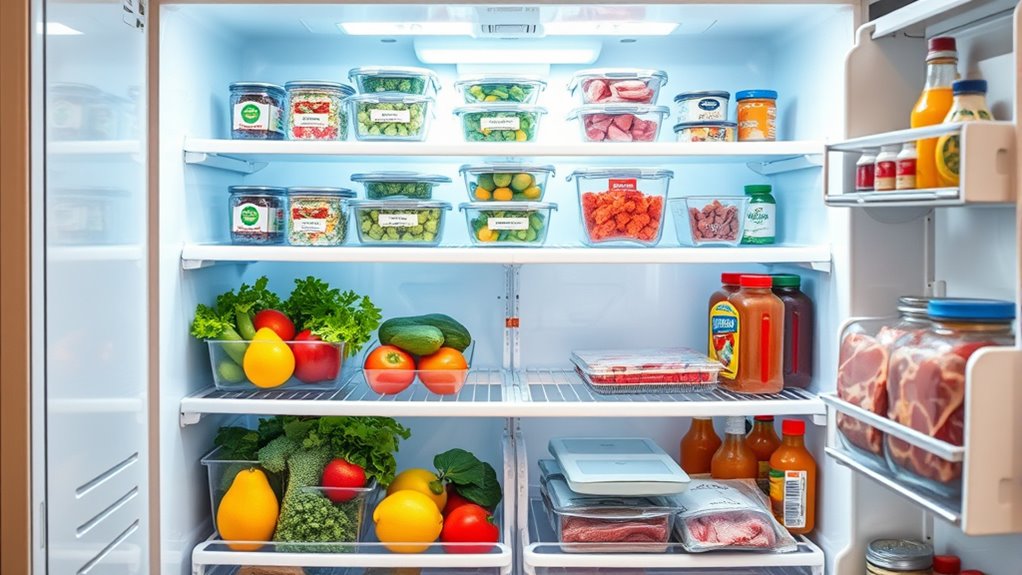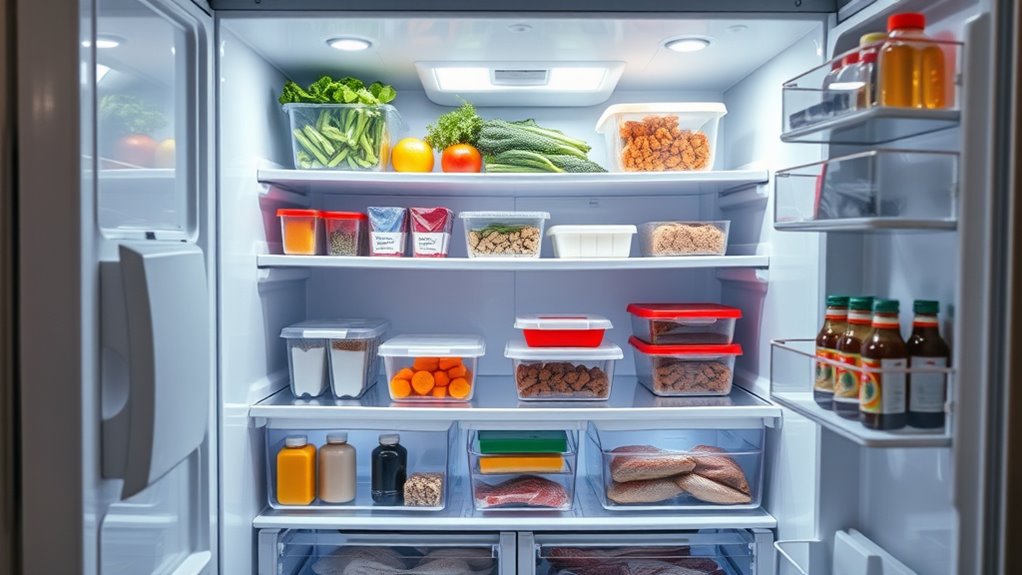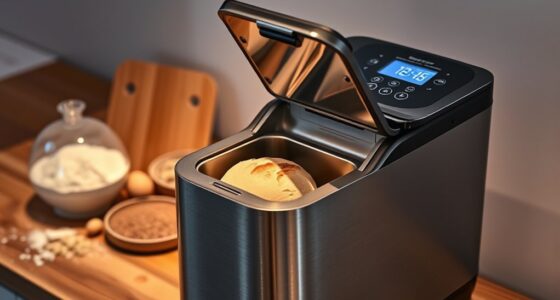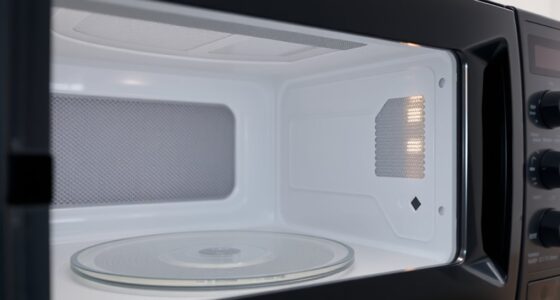To organize your refrigerator for food safety and efficiency, start by grouping similar items together and storing them in clear, labeled containers. Keep raw meats on the bottom shelf in leak-proof containers and store ready-to-eat foods higher up for easy access. Use crisper drawers for produce and regularly discard expired items. Maintain proper airflow and clean shelves often, while limiting door openings to preserve temperature. For detailed tips, you’ll find helpful guidance to optimize your fridge’s performance.
Key Takeaways
- Store raw meats on the bottom in leak-proof containers to prevent cross-contamination.
- Use clear containers and labels for easy identification and quick access.
- Keep perishable items before their expiry date to reduce spoilage and food waste.
- Place frequently used ingredients at eye level for convenience and minimal door openings.
- Regularly clean shelves and discard expired items to maintain hygiene and food safety.

A well-organized refrigerator makes meal prep easier, reduces waste, and keeps your food fresher longer. When you take the time to arrange your fridge thoughtfully, you’ll find it easier to plan meals efficiently, saving you time and energy. By strategically placing items based on how often you use them, you can streamline your shopping and cooking routines. For example, keeping ingredients for daily meals at eye level allows quick access, while less frequently used items can go towards the back or on higher shelves. This setup minimizes the need to dig through clutter, making your meal prep faster and less stressful.
An organized fridge also contributes to energy saving. When food is properly stored and visible, you don’t have to open and close the door repeatedly searching for ingredients, which helps maintain a consistent temperature. Keeping the fridge tidy ensures airflow isn’t obstructed, helping it operate efficiently and reducing energy consumption. Using clear containers or labels allows you to identify items quickly, avoiding unnecessary door openings. Additionally, storing leftovers and prepped ingredients in airtight containers not only prolongs freshness but also prevents spoilage, so you don’t waste food and energy on constantly replacing spoiled items.
Proper storage and visibility save energy by reducing door openings and maintaining airflow.
To optimize your fridge’s layout, start by grouping similar items together. Keep dairy products on the middle shelf, raw meats on the bottom (in leak-proof containers to prevent drips), and fresh produce in dedicated crisper drawers. These drawers are designed to maintain humidity levels ideal for fruits and vegetables, extending their freshness and reducing waste. Be mindful of temperature zones; the fridge’s coldest area, usually near the back, is best for storing leftovers and raw meats, while ready-to-eat foods should be placed in the less cold zones. Regularly wipe down shelves and discard expired items to maintain cleanliness and prevent cross-contamination, which is crucial for food safety. Proper airflow is essential to keep your fridge running efficiently and prevent spoilage.
Implementing a systematic approach to organizing your fridge means you’ll spend less time searching for ingredients, which in turn saves energy. When everything has a designated spot, you’ll open the fridge less often and for shorter periods. This not only reduces your energy bills but also helps keep your food fresher longer. A clean, well-organized refrigerator encourages better habits, like using up perishables before they spoil, cutting down on waste, and ensuring your food stays safe to eat. Ultimately, a little effort in organizing today can lead to a more efficient, cost-effective, and safer kitchen environment tomorrow.
Frequently Asked Questions
How Often Should I Clean My Refrigerator?
You should clean your refrigerator at least once every three to four months to maintain a good cleaning schedule. Regular cleaning helps prevent odors and keeps your food fresh. Wipe down shelves, throw out expired items, and clean spills promptly. For odor prevention, consider placing an open box of baking soda inside. Consistent cleaning not only keeps your fridge hygienic but also extends its lifespan and guarantees food safety.
What Temperature Should My Refrigerator Be Set To?
You want to keep your fridge at the perfect temperature, ideally around 37°F (3°C). This setting boosts energy efficiency and keeps your food fresh longer. But don’t just guess—use a thermometer to monitor the temperature regularly. Staying vigilant prevents spoilage and saves energy, making sure your fridge runs smoothly. Get it right now, and you’ll enjoy fresher food and lower utility bills—trust me, it’s worth the effort.
How Can I Prevent Cross-Contamination?
To prevent cross-contamination, you should guarantee proper air circulation and spill containment. Keep raw meats on the lowest shelves to avoid drips contaminating other foods. Use sealed containers or covers to contain spills and prevent bacterial transfer. Regularly clean the shelves and wipe up spills promptly. These steps help maintain a safe environment, reduce bacteria spread, and keep your fridge organized for ideal food safety.
Where Should I Store Leftovers?
You should store leftovers in clearly labeled storage containers to prevent confusion and cross-contamination. Place these containers on the middle or upper shelves, where the temperature is most consistent. Use a labeling system with dates to track freshness, and make certain lids seal tightly. This organization helps you quickly identify leftovers, keeps your fridge tidy, and maintains food safety, reducing waste and preventing spoilage.
How Do I Identify Expired or Spoiled Food?
Think of your food as a story unfolding; you can spot the ending by paying attention. Check expiration dates first—they’re like timestamps on a journey. Then, trust your nose: if it smells off or sour, it’s time to toss it. Feel for sliminess or discoloration, too. Using these clues, you’ll keep your fridge safe and fresh, avoiding spoiled surprises and savoring only the best.
Conclusion
By organizing your fridge properly, you not only keep your food fresh and safe but also make meal prep easier. Believe it or not, studies show that well-ordered refrigerators can reduce food waste and prevent cross-contamination. So, take a few minutes to implement these tips—your health and wallet will thank you. A tidy fridge isn’t just about convenience; it’s a smart move for food safety and efficiency that truly pays off.









